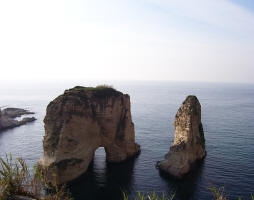 Water shortage forces Syria villagers into cities
Water shortage forces Syria villagers into cities
The ancient Inezi tribe of Syria reared camels in the sand-swept lands north of the Euphrates river from the time of the Prophet Mohammed. Now water shortages have consigned that way of life to distant memory.
Drought in the past five years has also killed 85 percent of livestock in eastern Syria, the Inezis' ancestral land.
Up to half a million people have left the region in one of Syria's largest internal migrations since France and Britain carved the country out of the Ottoman Empire in 1920.
Illegal wells to irrigate subsidized wheat and cotton have contributed to the destruction of the water table. Farms dependent on rain have turned into parched land. Diseases, such as wheat rust, have further devastated crops this season.
In the past decade rainfall has become scarcer, official data shows, shrinking to an average 152 mm from 163 in the 1990s and 189 in the 1980s. An unprecedented heat wave struck this year. Temperatures exceeded 40 degrees Celsius for 46 days in a row in July and August.
Syria has become a wheat importer, undermining a state policy of food self-sufficiency.
While climate models project the region will become hotter and drier this century, ministers and residents say other factors are exacerbating the problem.
Environment Minister Kawkab al-Dayeh told a water conference in Damascus last month pollution had played a role in the deterioration of 59 percent of total agricultural land, with raw sewage being widely used for irrigation.
Residents say corruption and mismanagement are the main reasons for the crisis. They cite badly run state-controlled estates, a legacy of Soviet-style policies, and irrigation canals dug to reach well-connected landowners in the naturally more fertile lands to the west.
Subsidies on fertilizers have been abolished, helping to lessen corruption, the agriculture minister said.
Agriculture's share of gross domestic product has fallen 10 percentage points to 13 percent in the past five years, official figures show. It still consumes 90-95 percent of Syria's water.
Tribal links with Saudi Arabia have helped the Inezis cope with the drought better than their compatriots in the east, who now live in slums around Damascus, Aleppo and Hama.
Women and children predominate in the concrete settlement of Jub Shaeer. The men are either in Saudi Arabia or trying to get there in search of menial jobs. Illiteracy and poverty are rife and government services are poor or non-existent.
International donors have been more active. The World Food Program is helping to feed 190,000 people, with another 110,000 needing rations. The United Nations estimates 800,000 of the eastern region's 5 million people live in extreme poverty.
Hekmat Jolaq, a government agricultural engineer, acknowledged that scaling back subsidies would help improve water availability, but said national security required Syria to maintain its policy of self-sufficiency in major crops.
Jolaq, who is also deputy head of the Raqqa Agricultural Engineers Union, said the solution lay in more investment, the streamlining of irrigation plans and adoption of technology.
"China has managed to cover whole desert areas with newly developed grazing plants," he noted.
| Contact information | n/a |
|---|---|
| News type | Inbrief |
| File link |
http://www.alarabiya.net/articles/2010/11/15/126245.html |
| Source of information | Alarabiya /REUTERS |
| Keyword(s) | drought, water shortage, irrigation |
| Subject(s) | AGRICULTURE , DRINKING WATER , DRINKING WATER AND SANITATION : COMMON PROCESSES OF PURIFICATION AND TREATMENT , FINANCE-ECONOMY , HYDRAULICS - HYDROLOGY , NATURAL MEDIUM , POLICY-WATER POLICY AND WATER MANAGEMENT , PREVENTION AND NUISANCES POLLUTION , RISKS AND CLIMATOLOGY , SANITATION -STRICT PURIFICATION PROCESSES , SLUDGES , WATER DEMAND , WATER QUALITY |
| Relation | http://www.semide.net/countries/fol749974/sy |
| Geographical coverage | Syria, |
| News date | 30/11/2010 |
| Working language(s) | ENGLISH |
 you are not logged in
you are not logged in





